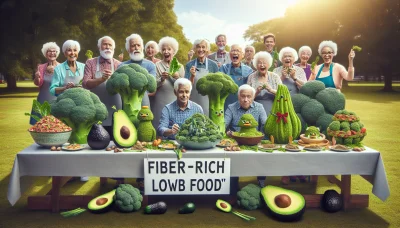High-fiber foods list lose weight Quiz
Test Your Knowledge
Question of
Understanding High-Fiber Foods
Fiber, an essential nutrient found in plants, is a heavyweight champion in the world of nutrition. High-fiber foods are not only crucial for digestion but also play a pivotal role in maintaining overall health. From fruits and vegetables to whole grains and legumes, incorporating fiber-rich foods into your diet can be a game-changer for your well-being.
Embarking on a fiber-filled journey is like unlocking a treasure trove of health benefits. Not only does it help with regularity, but it also aids in reducing the risk of chronic diseases such as heart disease, diabetes, and certain types of cancer. It's clear that high-fiber foods are more than just roughage; they're a path to a healthier life!
Benefits of Fiber in Weight Loss
Satiety and Hunger Control
Imagine feeling full and satisfied after every meal! That's the magic of fiber. It expands in your stomach, slowing down digestion and keeping those pesky hunger pangs at bay. This means you're likely to eat less and stay satisfied longer, which is fantastic news for anyone looking to shed some pounds.
Metabolic Enhancement
Fiber is not just about feeling full; it's a metabolic maestro! By regulating the body's use of sugars, fiber helps maintain hunger and energy levels. What's more, high-fiber foods require more chewing, which can lead to an increased calorie burn. Talk about a double win for weight loss!
Blood Sugar Regulation
Fiber's superpower extends to maintaining blood sugar levels, giving you steady energy throughout the day. This regulation helps prevent insulin spikes that can lead to cravings and overeatingkey factors in managing weight. With fiber on your team, you're well-equipped to combat those sugary temptations.
Types of Dietary Fiber
Soluble Fiber
Soluble fiber is like your friendly neighborhood mediator; it dissolves in water to form a gel-like substance that helps lower cholesterol and glucose levels. Found in oats, apples, carrots, and beans, this type of fiber is essential for heart health and keeping blood sugar levels stable.
Insoluble Fiber
The rough-and-tumble cousin of soluble fiber, insoluble fiber doesn't dissolve but instead adds bulk to your stool. This helps food pass more quickly through the stomach and intestines, promoting regularity. Whole wheat flour, wheat bran, nuts, and many vegetables are rich sources of insoluble fiber.
Functional Fiber
Functional fiber is the manufactured friend added to foods or supplements to boost fiber content. Whether isolated from natural sources or synthesized in a lab, these fibers have health benefits similar to naturally occurring fibers. They're often found in fortified foods and can be an additional tool in hitting your daily fiber goals.
- *Enumerative Lists: Used for itemizing elements, events, or tasks. -Ordered Lists: Sequence matters (e.g., procedural steps, rankings). -Unordered Lists: Sequence does not matter (e.g., grocery lists). *Descriptive Lists: Each item comes with details or description. *Checklists: Designed for tracking completion or presence. *Multilevel Lists: Nested lists with items having sub-items. *Matrix Lists: Organized both vertically and horizontally. *Priority Lists: Organized based on importance or urgency. *Comparative Lists: Juxtaposing items to highlight differences.
Daily Fiber Intake Recommendations
Guidelines for Men
Gentlemen! Your daily mission is to aim for about 38 grams of fiber if you're under 50 years old and 30 grams if you're 51 or older. Think whole grains at every meal! Meeting these targets can lead you toward victory against various diseases while keeping your digestive system running smoothly.
Guidelines for Women
Ladies! The spotlight's on you with a recommended intake of 25 grams of fiber per day if you're under 50 years old or 21 grams if over the age of 50. Embrace fruits with breakfast, veggies with lunch and dinnerit's time to make every bite count towards your daily triumph!
Adjustments for Weight Loss Goals
If weight loss is on the horizon, adjusting your fiber intake could be key. Adding just a little more fiber each day can contribute significantly towards achieving those goals while still enjoying delicious meals. Remember thoughincremental changes rather than drastic jumps will make this journey sustainable!
Top High-Fiber Foods for Your Diet
Fruits Rich in Fiber
Fiber-packed fruits are a delectable way to keep your digestive system running smoothly. Berries like strawberries, raspberries, and blackberries not only burst with flavor, but also contain a significant amount of fiber that can help maintain a healthy gut.
Don't overlook the humble apple or pear; when eaten with the skin on, these fruits are fiber powerhouses. The skin contains most of the fiber, so don't peel it away enjoy it for the fullest health benefits!
Exotic tropical fruits such as bananas, mangoes, and papayas bring a taste of paradise to your plate and offer an impressive fiber content. They're perfect for adding a tropical twist to your high-fiber diet.
Vegetables That Boost Fiber Intake
Leafy greens are not just low in calories; they're also rich in fiber. Spinach, kale, and Swiss chard can be easily incorporated into a variety of dishes, making them versatile allies in your quest for better health.
Cruciferous vegetables like broccoli, Brussels sprouts, and cauliflower are champions when it comes to fiber content. Not only do they help fill you up, but they also provide nutrients that support overall well-being.
When it comes to root vegetables, options such as carrots, beets, and sweet potatoes should not be ignored. These vibrant veggies are not only full of vitamins but also have a high fiber content that can aid digestion.
Whole Grains and Legumes
Ditch refined grains and make room for whole grains like quinoa, barley, and brown rice. These grains have their bran intact which is where all the fibrous action is! Including them in your meals can significantly increase your daily fiber intake.
Lentils, chickpeas, and black beans are legumes that pack a punch when it comes to both protein and fiber. Theyre incredibly versatile and can be used in everything from salads to soups.
Oats and bran cereals are breakfast champions with their high soluble fiber content which can aid in lowering cholesterol levels. Starting your day with these can keep you full longer while contributing positively to your digestive health.
- Berries: A cup of raspberries offers 8 grams of fiber.
- Apples & Pears: Eating them with skins provides more nutrients along with fiber.
- Tropical Fruits: Bananas contain prebiotic fiber, which helps nourish gut bacteria.
- Leafy Greens: Add them to smoothies or salads for an easy fiber boost.
- Cruciferous Vegetables: Steam or roast them to enhance their flavor while retaining nutrients.
- Root Vegetables: Roasting brings out their natural sweetness and maintains their fiber content.
- Whole Grains: Substitute white rice with quinoa or brown rice for added nutrition.
- Legumes: Rinse canned beans to reduce sodium while keeping the fiber benefits intact.
- Oats & Bran Cereals: Opt for unsweetened varieties to avoid excess sugar intake.
Integrating High-Fiber Foods into Meals
Breakfast Ideas to Start Your Day Right
High-Fiber Cereals and Oatmeal
Kick off your morning with a bowl of high-fiber cereal or oatmeal. Look for cereals with whole grains and at least 5 grams of fiber per serving. Amp up your oatmeal by adding nuts and berries, boosting both flavor and fiber!
Smoothies with Fiber-Rich Add-Ins
Smoothies can be a fiber powerhouse if you include the right ingredients. Blend in spinach, kale, or avocado for a green boost, and throw in a handful of chia seeds or flaxseeds for an extra fiber kick.
Whole Grain Toast Toppings
Whole grain toast provides the perfect canvas for a variety of high-fiber toppings. Smear on almond butter and top with sliced bananas, or go savory with avocado and tomato slices. Delicious and nutritious!
Lunch Options for Sustained Energy
Salads with a Fiber Punch
A salad loaded with vegetables is an excellent way to incorporate more fiber into your diet. Mix in chickpeas, quinoa, or sunflower seeds to transform your greens into a fulfilling meal.
Whole Grain Wraps and Sandwiches
Swap out white bread for whole grain wraps or bread to instantly increase your lunch's fiber content. Fill them with lean protein, plenty of veggies, and hummus for a satisfying midday meal.
- Mix it up: Try different whole grain breads like rye or spelt.
- Veg out: Don't skimp on the vegetables; they are not only rich in fiber but also nutrients.
- Beware of hidden sugars: Some whole-grain breads can have added sugars. Always check labels!
- Add legumes: Beans and lentils are not only protein powerhouses but also great sources of fiber.
Hearty Soups with Beans and Lentils
Soups are an excellent vehicle for beans and lentils, which are packed with fiber. A lentil stew or black bean soup can provide comfort as well as a considerable amount of your daily fiber needs.
Dinner Recipes for a Filling End to the Day
Stir-Fries with Fibrous Vegetables
Create colorful stir-fries using fibrous vegetables like broccoli, bell peppers, and snap peas. These ingredients add crunch, flavor, and an important dose of dietary fiber to your dinner plate.
Whole Grain Pasta Dishes
Elevate your pasta game by choosing whole grain varieties that contribute more fiber than their refined counterparts. Combine them with a tomato-based sauce loaded with veggies for an even greater fiber boost.
Bean-Based Casseroles and Chilis
Casseroles and chilis can be made healthier by incorporating beans. These legumes not only add texture and flavor but also significantly increase the meal's overall dietary fiber content.
Snacking on High-Fiber Foods
Snacking smart is a game changer, especially when it comes to maintaining your energy levels and supporting digestive health. High-fiber foods are your secret weapon! They help you feel full longer, manage weight, and keep things moving in the digestive tract. Not to mention, they play a crucial role in regulating blood sugar levels and cholesterol.
Fiber is a powerhouse nutrient that often gets overlooked in the hustle of daily life. But here's the kicker: it's incredibly easy to incorporate into your snacks! With a little creativity, you can transform your snacking habits with delicious, fiber-rich options that pack a nutritional punch without skimping on flavor.
Portable Fiber-Rich Snacks
Let's dive into the world of on-the-go snacking with fiber at the forefront! Portable snacks are lifesavers when you're out and about. They prevent hunger pangs and provide sustained energy throughout the day. The key? Choosing snacks that are not only convenient but also loaded with fiber.
Imagine this: a small container filled with crunchy nuts and seeds or a colorful array of fresh fruit pieces waiting for you when hunger strikes. Or how about crisp vegetable sticks paired with a zesty hummus or creamy guacamole? These snacks aren't just tasty; they're nutritional powerhouses that will keep you fueled and satisfied.
- Nuts and Seeds Mixes: A handful delivers a quick protein and fiber boost.
- Fresh Fruit Pieces or Dried Fruit: Naturally sweet and full of vitamins.
- Vegetable Sticks with Hummus or Guacamole: Crunchy, creamy, and utterly satisfying.
High-Fiber Baking Recipes
Baking doesn't have to be about sugar-laden treats! By tweaking traditional recipes, you can bake up some deliciously fiber-rich goodies that will make both your taste buds and your gut happy. It's all about substituting refined flours with whole grains and adding ingredients like nuts or seeds for an extra fiber kick.
Create muffins that are not just mouth-watering but also brimming with nutrients by using bran or whole wheat flour. Whip up homemade granola bars packed with oats, nuts, and seeds - perfect for breakfast on the run or an afternoon snack. And let's not forget cookies; yes, cookies can be part of your high-fiber diet when you add flaxseed or other fiber sources!
Indulgent Yet Healthy Treats
Who says indulgence can't be healthy? When those cravings hit, reach for treats that satisfy both your sweet tooth and your body's need for nutrition. Dark chocolate paired with almonds offers an irresistible combo of richness and crunch while providing antioxidants and fiber.
If popcorn is your go-to snack, jazz it up with nutritional yeast or spices for an extra flavor punch without compromising its high-fiber benefits. For something naturally sweet, baked pears or apples sprinkled with cinnamon are not just comforting but also incredibly nutritious - talk about a guilt-free dessert!
The Role of Fiber in Popular Diets
Fiber in Low-Carb Diets: Balancing Nutrition
Integrating fiber into a low-carb diet can be a thrilling tightrope walk, but it's absolutely achievable! It's all about selecting foods that are rich in fiber yet low in carbohydrates. Think leafy greens, nuts, and seeds - these are your new best friends. They pack a punch of fiber without throwing you off your carb count for the day.
The impact on ketosis, a metabolic state sought after in low-carb diets, is minimal when choosing the right fiber sources. Soluble fiber can actually benefit those aiming for ketosis, as it doesn't significantly affect blood sugar levels. So go ahead and enjoy your avocados and berries!
Now, let's talk strategies for incorporating fiber without overloading on carbs. It's simpler than you think! Focus on non-starchy vegetables and supplement with flaxseeds or chia seeds. These tiny powerhouses add fiber and texture to meals without compromising your carb goals.
Choosing High-Fiber Low-Carb Foods
When zeroing in on high-fiber, low-carb foods, the choices are both delicious and diverse. Almonds, for example, offer a satisfying crunch and are a fantastic source of both fiber and healthy fats. And let's not overlook the humble cauliflower it's incredibly versatile and can be transformed into anything from rice to pizza crust!
The Impact on Ketosis
Maintaining ketosis while ensuring adequate fiber intake is a game-changer for many embarking on a low-carb journey. Fiber-rich foods like green vegetables contribute minimal net carbs due to their high fiber content - which means they have little to no impact on your ketosis status.
Strategies for Incorporating Fiber without Excess Carbs
- Embrace Greens: Spinach, kale, and other leafy greens should become staples in your meals.
- Opt for Seeds: Chia seeds and flaxseeds are excellent for adding fiber to shakes or yogurts.
- Savor Berries: Raspberries and blackberries offer sweetness plus fiber while keeping carbs low.
- Selective Snacking: Choose nuts like pecans or walnuts for high-fiber snacking options.
- Fiber Supplements: Consider a high-quality fiber supplement if you're struggling to meet your goals through food alone.
Plant-Based Diets and Fiber Intake
A plant-based diet naturally screams high-fiber! Vegans rejoice because getting enough fiber is typically not an issue with such an array of fruits, vegetables, whole grains, nuts, and seeds at your disposal. This abundance ensures that you're not just meeting but often exceeding daily fiber recommendations.
The variety of plant sources available makes it easy to keep things exciting in the kitchen. From quinoa to beans and lentils each provides not just fiber but also essential nutrients that support overall health. Plus, they're incredibly versatile; whether you're making soups or salads, there's always room for more plants!
Getting Enough Fiber on a Vegan Diet
Finding enough fiber on a vegan diet can be as simple as embracing the rainbow fill your plate with colorful fruits and vegetables at every meal! Add to that some whole grains like brown rice or barley, and you've got yourself a fibrous feast that supports digestive health and keeps you feeling full longer.
The Variety of Plant Sources
Dive into the variety of plant sources available! Lentils aren't just good for soups; they make great burger patties too! And if you haven't tried chia seed pudding yet what are you waiting for? It's an easy way to up your fiber intake first thing in the morning.
Mediterranean Diet: A High-Fiber Eating Plan
The Mediterranean diet is celebrated not just for its flavors but also its health benefits high-fiber eating is at its core. With an emphasis on fruits, vegetables, nuts, seeds, legumes, whole grains, and olive oil, this diet is synonymous with good digestion and heart health. It's truly a lifestyle worth adopting!
Core Components of the Mediterranean Diet
Olive oil isn't just for salads; it's the heart-healthy fat that forms the basis of the Mediterranean diet. Combine that with whole grains like farro or bulgur wheat; add some legumes into the mix now we're talking real Mediterranean magic!
The Role of Whole Grains and Legumes
Lentils, chickpeas, beans these aren't just side dishes; they're Mediterranean staples packed with both protein and fiber. And when it comes to whole grains? We say bring on the barley, freekeh, and whole wheat pasta! Each bite brings you closer to meeting those daily dietary goals.
Incorporating Fruits and Vegetables in Every Meal
Incorporating fruits and vegetables into every meal is second nature within the Mediterranean lifestyle. Breakfast might feature a tomato rubbed onto whole grain toast drizzled with olive oil; lunch could be a hearty vegetable stew; dinner? A vibrant salad full of fresh produce from the market!
Overcoming Challenges with High-Fiber Diets
Managing Digestive Issues When Increasing Fiber
Embarking on a high-fiber diet can be a game-changer for your health, but it's not uncommon to hit some digestive snags along the way. When you introduce more fiber to your diet, your gastrointestinal system might need time to adjust. You might experience bloating or changes in bowel movements, but don't worry this is normal and usually temporary.
Gradual Increase of Fiber Intake
Ramping up your fiber intake slowly is key to reducing potential discomfort. Abruptly increasing fiber can shock your system, leading to gas and bloating. Instead, add high-fiber foods incrementally over weeks, allowing your body to adapt gracefully. This gradual approach helps mitigate the initial side effects and makes the transition smoother.
Importance of Adequate Hydration
Fiber works best when accompanied by plenty of fluids. Water acts as fiber's sidekick, helping it move through your digestive system effectively and preventing constipation. Aim for at least eight glasses a day hydration is a powerhouse move when adapting to a high-fiber diet!
Recognizing Signs of Too Much Fiber
Even too much of a good thing can be problematic. If you notice signs like chronic bloating, abdominal pain, or too frequent bowel movements, you might be overdoing it on fiber. Listen to your body and adjust accordingly finding the sweet spot for fiber intake is crucial for maintaining gut harmony.
Balancing Nutrient Absorption with High Fiber
A high-fiber diet brings a plethora of benefits but can also bind with certain minerals, affecting their absorption. The trick lies in striking the right balance so that you can enjoy the positives without losing out on vital nutrients like iron, zinc, and calcium.
Timing Fiber Intake Around Other Nutrients
To maximize nutrient uptake, consider timing your fiber intake strategically. For instance, if you're taking supplements or eating mineral-rich foods, give them some space from high-fiber meals. This separation allows your body to absorb these nutrients more efficiently without fiber muscling in on the action.
- Avoid consuming high-fiber foods together with iron or calcium supplements.
- Eat nutrient-dense foods earlier in the day and reserve high-fiber meals for later.
- If taking medication, consult with a healthcare provider about optimal timing with fiber intake.
Sticking to a High-Fiber Diet Long-Term
Maintaining a high-fiber diet over the long haul requires planning and perseverance. It's not just about enduring; it's about thriving! With smart strategies in place, you'll find that sticking to this beneficial eating pattern becomes second nature.
Meal Planning and Preparation Tips
Planning is pivotal when it comes to sustaining a high-fiber diet. Set aside time each week to map out meals and snacks. Preparing batches of fiber-rich foods like beans or whole grains ahead of time ensures that you always have healthy options on hand no more reaching for low-fiber convenience foods!
Measuring the Impact of High-Fiber Foods on Weight Loss
Tracking Progress with Dietary Changes
When you start incorporating high-fiber foods into your diet, it's crucial to track your progress meticulously. This isn't just about stepping on the scale; it's about understanding how dietary changes affect your body. A food diary can become your best friend in this journey, helping you pinpoint what works.
Monitoring both weight and body measurements provides a comprehensive picture of your progress. Fluctuations in weight can be misleading, but measurements can show you the real story. Keep an eye on how your clothes fit, and use a tape measure to track changes in your waist, hips, and other areas.
You'll likely notice changes in appetite and digestion as you increase fiber intake. Fiber-rich foods may help you feel fuller longer and could lead to a natural reduction in calorie consumption. Pay attention to these cues from your bodythey're signs that high-fiber foods are starting to work!
Scientific Research on Fiber and Weight Management
Studies have shown a strong link between dietary fiber and obesity prevention. Researchers have found that high-fiber diets are associated with lower body weight and reduced risk of gaining excess fat. Its not just about calories; its about the quality of the food we eat.
The long-term effects of a high-fiber diet go beyond initial weight loss. Sticking to a diet rich in fiber can contribute to sustained weight management and overall health improvements. Consistency is key; making fiber a permanent part of your diet can help maintain these benefits over time.
Fiber plays a critical role in preventing weight regain, which is often overlooked in weight loss discussions. By stabilizing blood sugar levels and enhancing satiety, high-fiber foods ensure that youre less likely to fall victim to cravings and binge eating.
Personal Success Stories: Before and After High-Fiber Diets
The internet is brimming with testimonials from individuals who have lost significant amounts of weight by embracing high-fiber diets. These stories often highlight not just the weight loss itself, but also the increased energy levels, better skin health, and improved digestion that come along with it.
- Lifestyle changes accompanying high-fiber diets frequently include increased physical activity, mindful eating practices, and better hydrationall essential for sustainable weight loss.
- Maintaining weight loss with a high-fiber lifestyle often involves creating lasting habits rather than relying on short-term diets. It's about making smarter food choices consistently.
- It's important to remember that everyone's body responds differently to dietary changeswhat works for one person might not work for another. Patience and personalization are key components of success.












